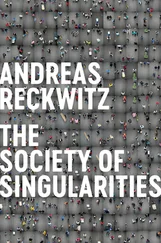As mentioned above, cultural-essentialist currents largely take the form of movements that oppose the developmental trends of hyperculture that are systematically favored, and have become dominant, in Western societies. Of course, instantiations of cultural essentialism have historical precursors – such as the nationalist movements in the nineteenth century, with their discovery of the “people” (and even of “race”) – but in late modernity they have a different social significance: they can be interpreted as a mobilization of peripheries against society’s center , and this is true both within national societies and on the global level. This mobilization of peripheries does not take the form of class conflicts in the traditional (social-material) sense; instead, it adopts the form of identity conflicts . 21
As diverse as the individual forms of cultural essentialism may be – ethnic communities, religious fundamentalisms, nationalism, right-wing populism – they all share in common the fact that they are overwhelmingly represented by population groups that, over the course of the transformation from industrial modernity to the post-industrial society of singularities, perceive themselves as losers of modernization. In terms of social structure, we are dealing here with members of the new underclass and the old middle class. 22For the latter, hyperculture and its cosmopolitanism are the domain of “elites,” whereas their collective identity movements are the medium in which the disgruntled, devalued, and aggrieved have come together to oppose what they perceive to be their unjust loss of social status and cultural influence. In this late-modern iteration of cultural essentialism, feelings of superiority and inferiority form an unusual alliance: those who feel inferior attempt to establish their own superiority via a collective identity.
At the same time, cultural essentialism can also be interpreted on the global level – that is, in the relationships between national societies – as a mobilization of the peripheries against the center. In this case, the “center” is a real or imagined West from which forms of cultural essentialism in Russia, Turkey, Hungary, China, or India – in countries, that is, that perceive themselves as victims of Western hegemony – are attempting to distance themselves. 23Here, too, it is the case that discrimination and perceived affronts from the privileged – that is, from “the West” (in the form of the British as former colonizers, the United States as a superpower, the European Union under German and French leadership, etc.) – have been transformed into self-ascriptions of presumed superiority, which are meant to secure the identity of the slighted nations in question. If cultural essentialism exerts any influence beyond the social groups that have been left behind by modernization, it does so on the level of the state – for instance, through government-supported cultural, educational, and immigration policies.
Hyperculture and Cultural Essentialism: Between Coexistence and Conflict
What we have witnessed in many areas of late modernity is a polarization between two regimes of culturalization: between hyperculture and cultural essentialism. Only by adopting this abstract perspective does it become clear that, in fact, mutually hostile groups – such as the Salafists or Marine Le Pen’s National Rally, Evangelicals or Russian nationalists – follow the same pattern, namely that of Culturalization II. They may fill cultural essentialism with different content, but they employ one and the same schema of culturalization, which they mobilize in fundamental opposition to the other schema – that is, against Culturalization I. This is where my interpretation differs most explicitly from Samuel Huntington’s. In Huntington’s view, the various national varieties of religious fundamentalism, right-wing populism, and nationalism each formed their own distinct “cultures,” whereas now it is clear that they all follow the same pattern. Conversely, “the West” does not simply constitute an additional culture, as Huntington suggested; rather, in its late-modern instantiation, it enables a form of culturalization that is structured in a fundamentally different manner: Culturalization I (hyperculture). That said, it would be too simple a dramatization to characterize the relationship between these two regimes as one of “the West against the rest.” As I have already mentioned, the historical roots of hyperculture may lie in Europe and North America, but it has long since globalized beyond these trans-Atlantic confines. Conversely, moreover, cultural essentialism is by no means restricted to just Asia or Eastern Europe but is, rather, prevalent in Western Europe and the United States as well. “The West” is not a spatial, geographical concept; it is a symbolic concept.
What happens when hyperculture encounters cultural essentialism? 24Many of today’s global and intra-societal conflicts can be deciphered as part of the conflict between these two regimes of culturalization. In this conflict, there are always two possible ways for each side to deal with the other: a strategy of coexistence qua assimilation, and a strategy of rejection as an absolute enemy. Assimilation entails making attempts to integrate phenomena of the other cultural regime into one’s own perspective and thus to make them manageable and coexist with them. Rejection as an absolute enemy entails perceiving the radical otherness of the different cultural regime and, accordingly, dramatizing this relation in the form of a friend–enemy schema. In all, there are thus four possible strategies for dealing with one another, and there are plenty of empirical examples of each one (see Table 1.1).
Table 1.1 Relations between Culturalization I and Culturalization II
|
Culturalization I in relation to Culturalization II |
Culturalization II in relation to Culturalization I |
| Coexistence |
Multiculturalism |
Theory of cultural spheres |
| Antagonism |
“Open society and its enemies” |
“Decadence of the West” |
During the 1980s and 1990s, one formula for coexistence between hyperculture and cultural essentialism was multiculturalism. 25The multiculturalism of Western liberals proceeded from the idea that diverse ways of life represent a fundamental enrichment, so that ethnic or religious communities, for instance, were tolerated even if they were relatively closed off. Essentially, multiculturalism looked at cultural communities through a pair of cosmopolitan-diversity glasses, and what it saw was groups cultivating different lifestyles in which people chose to participate. The result, in short, was that orthodox Islam, veganism, and teenage subcultures were all regarded as being on the same level. From the perspective of multiculturalism, different sorts of groups are embodiments, as it were, of cultural options and styles, and they make no claim to absoluteness. Cultural capitalism, too, is ultimately based on economically applied multiculturalism: cultural communities with local roots thus appear as welcome contexts or reservoirs from which “authentic” cultural goods can be drawn, and these goods can then be commodified and appropriated (the tattoos of sailors, Middle Eastern cooking, the meditation of Buddhist monks, and so on).
Conversely, cultural essentialism has also produced its share of strategies for coexisting with liberal hyperculture. One common strategy consists in viewing cosmopolitanism itself as the worldview of a foreign cultural community that, though peculiar, is not threatening. This attitude is apparent, for instance, in the behavior of non-Western governments that, in response to accusations of violating human rights, insist on the value of their native traditions. From this viewpoint, liberal cosmopolitanism appears, in a sense, as a special feature of the Western cultural community and its history: Westerners may indeed support hyperculture, and they are free to do so – but only on their own turf! From this perspective, which is based on a political theory of cultural spheres , different cultures are ultimately thought of as being distinct from one another, and cosmopolitan hyperculture represents just one of these varieties: the sphere of Western (that is, North American and Western European) culture.
Читать дальше









